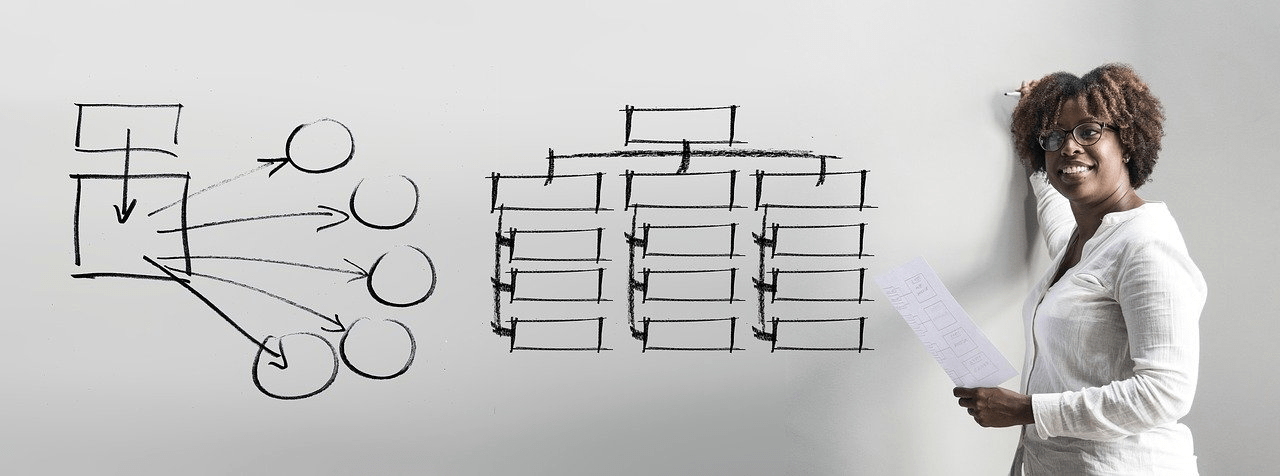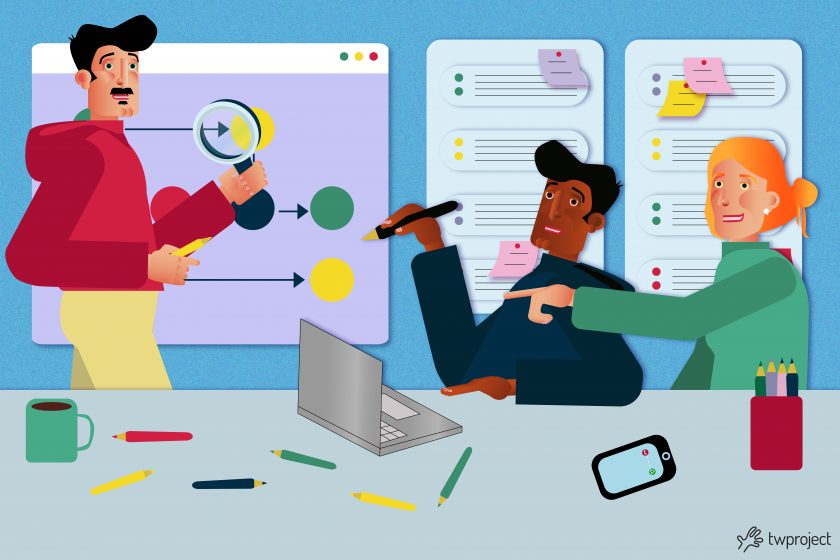Which methodology between Waterfall vs. Agile to choose? Every project comes with its own set of unique challenges, and this decision—whether to adopt a waterfall approach or embrace agile development—comes up in every scenario.
Now, more than ever, it is crucial to ensure that the development methodologies used by an organization are tailored to the specific circumstances.
In fact, each option affects the speed of the project and the overall chances of success differently.
In this article, therefore, we would like to provide insight into which methodology to choose for project management.
CONTENT
- What is Waterfall methodology?
- What is Agile methodology?
- How to choose the right project management methodology
- Project complexity
- Inflexibility
- Project values
- Business culture
- Waterfall and Agile: best practices for hybrid adoption
- Why many organizations choose the hybrid model
- Waterfall or Agile? Why choose, when you can have both with Twproject
What is Waterfall methodology ?
The Waterfall model is a sequential methodology based on a clearly defined scope that centers on the collection of preliminary requirements and then follows a set order.
This means that when each of the Waterfall steps is successfully completed, the team members move on to the following step.
The more strict, linear nature of the Waterfall methodology makes it the perfect choice for simple, specific activities.
It is easy to manage, comes with specific deliverables and well-defined starting and ending points.
Nevertheless, it is easy to see how this methodology is less flexible than the alternatives.
Since this plan is sequential and linear, any changes become relatively costly and time-consuming.
Because the waterfall model relies on upfront requirements gathering, development teams must fully align with stakeholders before execution begins.
This means that a solid understanding must be met and shared by all parties.
The Waterfall methodology excels when project requirements are fairly static, but would not be adequate for the delivery of a complex product that could change frequently and abruptly.
For waterfall projects, a well-structured project plan is fundamental as it establishes final deliverables, deadlines, and responsibilities right from the start, promoting long-term planning without unexpected deviations.
What is Agile methodology?
The agile approach is designed around flexibility.
Teams typically begin with a basic project design and break it down into a small set of activities, which are reviewed, tested, and evaluated at the end of each so-called “sprint”.
These sprints allow them to identify issues, bugs or incorporate customer feedback into the design before the next sprint is performed.
With agile development, development teams work in short cycles—often two to four weeks—so that feedback can be incorporated quickly and the product can evolve organically.
Agile methodology is great for projects where the outcome is not clearly defined but the goal is.
Work can evolve based on team input, stakeholder feedback and customer opinions.
The result is a product that both incorporates updated end-user and stakeholder feedback and is therefore ultimately more likely to be successful.
On the other hand, agile project flexibility can also be its ruin, as it presents a greater opportunity for projected timelines and costs to be compromised as the project evolves.
A well-defined set of measurable goals is critical to ensure smooth alignment.
Without a defined end to the construction process, sprints can continue for many months.
The only clue is how close the product is to achieving the goals and how those goals are aligned with value.
This pattern depends on how much change tolerance a project demands.
If the requirements are tangible and merely have to be executed, the flexibility of Agile provides little value.
However, considering the increasing complexity of each market, this “certainty” becomes increasingly unlikely.
How to choose the right project management methodology

There is no one size fits all approach for choosing a successful project management methodology.
However, there are a few aspects to consider to ensure that the most appropriate approach is selected. These are:
Project complexity
First, it is important to regard the project in terms of simplicity or complexity.
For simple projects, a linear methodology such as Waterfall will ensure that time and budget expenses are in line with the simplistic nature of the work.
Conversely, in the case of complex products, an Agile approach ensures that every aspect of the project is refined iteratively, resulting in higher success rates.
Inflexibility
If you are working with set schedules, budgets and delivery requirements, a methodology such as Waterfall is almost certainly the best choice to ensure that metrics are met.
It is critical to consider this aspect thoughtfully, as choosing the wrong methodology due to the inflexibility of the project can greatly increase the risk of breaking time and budget constraints and ultimately cause the project to fail.
Project values
What do the customer, stakeholders, and end user value most?
For example, if stakeholders value the ability to consistently review and suggest iterative updates, the Agile methodology may be best option.
Business culture
Arguably one of the most important steps in choosing a suitable methodology is to conduct an in-depth study of what the team and organization value most.
Every organization have its own corporate culture, habits and values, and adopting a trending methodology that goes against it will most likely result in failure.
Waterfall and Agile: best practices for hybrid adoption
- Define the macro-phases in Waterfall: identify the moments where deviations cannot be tolerated (e.g. production release, audits, contractual milestones) and set them as “Waterfall phases”.
- Break down internal activities into Agile sprints: within each macro-phase, create short work cycles (1–2 weeks) to collect continuous feedback and adapt the product.
- Integrate retrospectives: schedule a retrospective not only at the end of each sprint, but also at the end of each Waterfall macro-phase, to capitalize on lessons learned and refine the overall process.
- Automate notifications and follow-ups: Automatically send reminders when a phase is nearing its deadline or a sprint is not meeting its predefined goals.
Why many organizations choose the hybrid model
- Optimization of time-to-market by balancing rigorous planning and reactive agility:
Organizations can’t afford to wait months for a “perfect” product. With the hybrid model, critical macro-phases (release, compliance, audit) are planned using Waterfall, ensuring reliable roadmaps and deadlines, while development and improvement activities are handled through Agile sprints. This approach guarantees the continuous delivery of minimal but functional features, reducing time-to-market without sacrificing overall quality.
- Greater transparency through unified tools showing both linear and iterative progress:
By using both Gantt charts and Kanban boards within the same platform, all stakeholders always have a clear view of progress: they see the “Waterfall” milestones and ongoing activities within the sprints. Integrated reports and dashboards make metrics such as completion percentage, hours worked, and remaining backlog visible, eliminating information silos and enabling fast, shared decisions.
- Risk reduction by breaking down complexity into manageable watdeliverables and adjusting through cyclical feedback:
Splitting a complex project into Waterfall blocks and Agile sprints allows you to isolate areas of greatest uncertainty (new technologies, integrations, regulations) within short cycles, where problems can surface quickly and be addressed without impacting the entire plan. Retrospectives and Waterfall checkpoints serve as “release valves” for implementing course corrections, reducing the risk of major failures or delays.
Waterfall or Agile? Why choose, when you can have both with Twproject
As we saw previously, there is no single framework that is always the best choice.
Waterfall and Agile methodology both have their pros and cons, the important thing is to use them in the right way and at the right time, leveraging their strengths when the circumstances call for it.
As such, good project management software, like Twproject, can help integrate the two methodologies and gain the maximum benefits.
Thanks to a variety of features, Twproject allows you to assess the project circumstances and its elements and figure out which approach is best to follow.
Many organizations currently choose a mixed approach, using multiple methods where they are most suitable.
Furthermore, to ensure the success of a project, it is crucial to clearly define each phase of the process and assign roles to team members with the appropriate skills. A well-structured kickoff, a regular communication plan, and a retrospective at the end of each iteration help maintain high quality and motivation.
Implementing performance metrics and continuous feedback loops allows for course correction early on, reducing risks and unforeseen issues.
Good project management software can therefore help in choosing and organizing work by increasing the likelihood of success.




